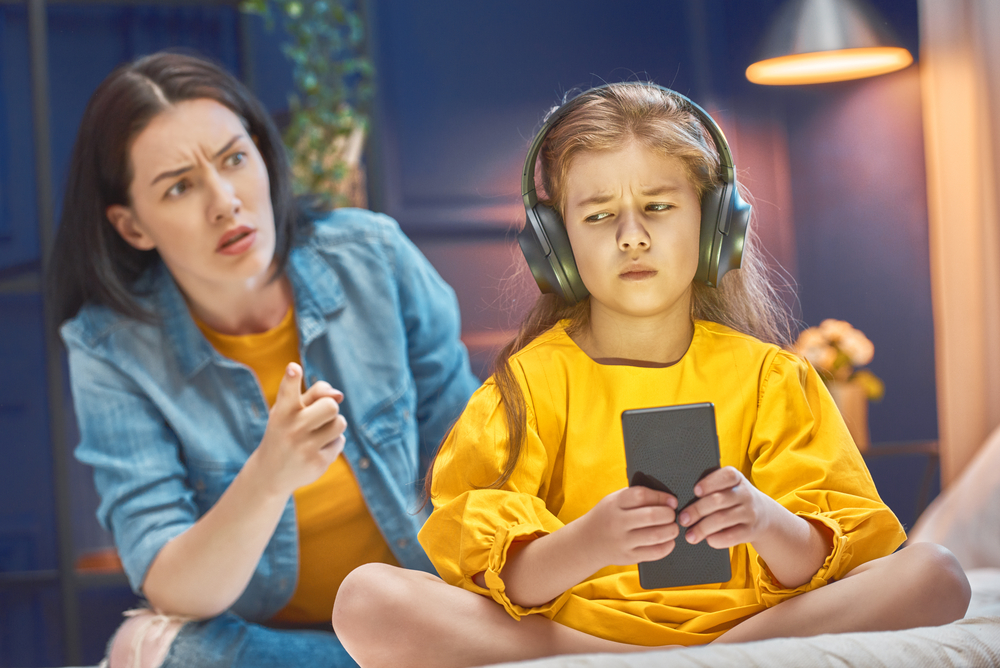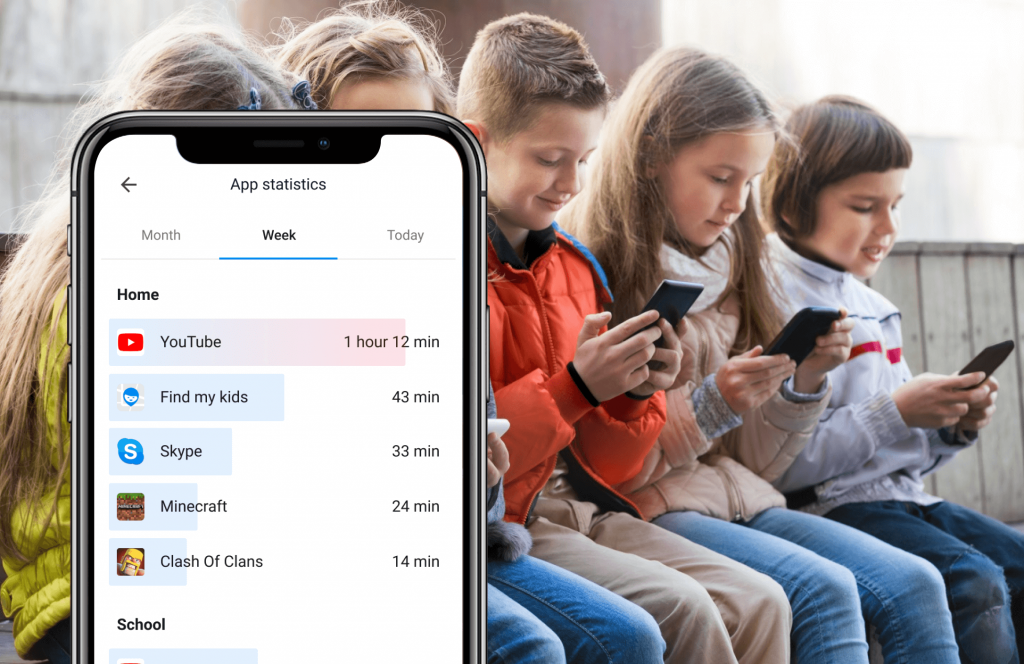Setting Healthy Screen Time Limits for Kids and Toddlers

Kids as young as 1-year-old are learning how to use phones, tablets, and other handheld devices. But how much screen time is too much and how can parents set healthy limits? When adults struggle with cell phone addiction and limiting their own screen time, it’s no wonder that kids would need some help with managing their time on devices.
Contents:
- The Problems with Screens
- What Age is Appropriate to Introduce Screens?
- Developing Screen Time Rules for Kids
- Setting Limits for Older Children & Teens
The Problems with Screens

Setting your child up with a device may seem harmless at first, but more and more research has been done on the harmful effects of too much screen time. There are many issues with screens for young children including:
- Educational deficits. Too much screen time can negatively impact a child’s ability to learn. The endless scrolling features of many videos and social media apps such as YouTube can reduce an individual’s attention span and make it hard to maintain focus on one task at a time.
- Poor sleep habits. In addition to kids not wanting to go to bed because they’d rather be on their device, the actual type of light given off by electronic devices can make it even harder for little brains to shut down and be ready to sleep. This can be mitigated somewhat by using nighttime mode or using special blue light screen filters, but it is best to remove all devices from your child’s bedroom at least 1 hour before you want them to fall asleep.
- Obesity. The lack of physical activity due to time being spent sedentary on screens can contribute to an increased risk of obesity in kids and teens.
- Addictive Tendencies. Even adults have trouble with the perils of screentime addiction. Too much screen time is even worse on developing brains. According to one study, excessive screen usage affects the cortex of the brain!
- Behavioral Issues & Poor Social Skills. Time spent on screens cuts back on the time your child learns how to engage and interact with the real world. And every parent has experienced the struggle of an upset child who doesn’t want to put down the iPad or video game.
Are some screens worse than others? Screen time for your child could include a cell phone, tablet, computer, TV, or video game console. All screen time is alike in that it prevents your child from engaging in other activities that could be more beneficial for them such as face-to-face communication or playing outdoors.
The average American child spends 7.5 hours a day using screens and less than one hour being active. The more you can limit your child’s screen time use (on all devices) and encourage other activities – the better.
What Age is Appropriate to Introduce Screens?

In this day and age, it’s simply not realistic for most families to completely limit screentime altogether in their households. Young children and toddlers see the rest of the family using their devices, and simply want to imitate and be involved as well. Many families find themselves asking at what age they should consider introducing screens to their little ones? Is screen time always bad for toddlers?
as tempting as it can be to calm or quiet your toddler with a phone or tablet, in the long run, it may not always be the best choice for their emotional growth and mental development. According to research, screen time for toddlers can cause a variety of issues including a shorter attention span, desensitization to violence, behavioral issues, anxiety, and even developmental delays. On the other hand, there are times when screentime for toddlers and young children can be beneficial, such as using FaceTime to communicate with a parent who is out of town or at work, engaging with educational apps, or bonding with a caregiver while watching a movie or playing a game together.
So how much screen time is OK for a toddler? The AAP recommends that toddlers younger than 18 months avoid all electronic device usage altogether and that young children between the ages of 2 and 5 only use screens for a maximum of 1 hour per day. What about older children? How much screen time is healthy for a child? As children reach school age, the recommended allowance increases to 2 hours to allow for time to complete homework, engage in school assignments while at school during the day, and communicate with friends via the phone or tablet.
These limits may not be realistic for your family, especially in our post-COVID-19 digital world. But in general, parents should make sure that children are receiving the appropriate amount of sleep each night and spending at least 1 hour a day engaging in some sort of physical activity.
For any family allowing screen time for young children and toddlers, it is best to closely monitor how much time they are spending on the device and limit the type of material and content they consume. For example, toddlers should only be using screens for video calls or educational content and with a caregiver present whenever possible.
Read also What Age Should a Kid Get a Phone? The Ultimate Guide to Deciding.
Developing Screen Time Rules for Kids

Developing screen time rules for your kids is the best way to ensure a healthy balance between time spent in the digital world and time spent in real life. Having clear boundaries on screen time usage sets you and your child up for success as kids learn the rules and know what is expected of them. It is important to also have consequences for breaking the rules you set up for the family.
What strategies can parents use to limit screen time for their kids? Below are some of the best ways families can get a handle on their kids’ technology usage.
Model Good Digital Behavior
Kids live by the rule of imitation. Don’t set up an environment in which the standard for your kids is “do as I say; not as I do”. If you want your kids to learn healthy screen time limits, you will need to model them yourself.
Encourage Outdoor Time
The best way to break an unhealthy habit is to replace it with a healthy one! Go for a family bike ride or encourage your kids to try to start a pick-up game of baseball or basketball with neighborhood kids next door. The more time your kids spend outdoors and being active with others – the less appealing time inside on screens will seem.
Set Up “Screen-free Times”
Many families find great success with enforcing certain rules around when screens can be used. For example, you may decide that you will not allow screen time in the morning, at bedtime, at the dinner table, in the car, during family time, or before homework is complete.
Special exceptions can be made for holidays, weekends, days off of school, the summer months, etc. Let your child know upfront what the rules and expectations are, for example: “I am going to give you your iPad for 1 hour, and then it will be time for bed.”
Use Transitions
Giving special attention to transitions is especially helpful for young children who often still have trouble shifting from one activity to the next. No one wants to be told to stop what they are doing immediately if they are immersed in a game or in the middle of a movie or TV show. You may want to consider telling your child phrases such as “once this show is over, it is time to put the iPad away and come eat dinner” or giving time-based warnings such as “you have 5 more minutes to watch TV before you need to start getting ready for bed”.
Give Reasonable Choices
Helping your children feel in control of their screen time usage will reduce tantrums and also set them up for making healthy choices as they get older, and you become less and less involved. You can ask young children questions like: “Would you like to watch a movie on your iPad or play a game on the computer while I cook dinner?” or “You can play your video game for 30 minutes right now or I will let you play it for 1 hour tomorrow.”
Setting Limits for Older Children & Teens

Setting limits may look a little bit different for older children and teens. In addition to the tips above consider adding these methods:
Set The Rules
It sounds simple but remember that YOU are the parent. You are the one who gets to set the rules with your child’s electronic device. Especially with teenagers, it can be too easy to let them dictate their own phone usage, but this isn’t wise or safe. You get to decide when they get a phone (after all, you pay the bill) and whether or not they continue to earn the privilege. Teenagers must prove themselves with healthy, responsible phone usage.
Create a “Curfew”
All screens should be removed from bedrooms and shut off at least 30-60 minutes before bedtime. Not only do they become a distraction, but they also stimulate the mind and make it difficult to experience good sleep. For older children and teens, at night is when they may be more likely to get into trouble with their cell phone usage. Take away or even lock up all cell phones at night whenever possible.
Use Parental Control Apps

The Findmykids app
This tip is especially beneficial for parents of older kids who can’t simply take the iPad away when you want your child to stop watching so much digital content. Using parental control apps and screen time limit apps helps place a fence around your child’s media usage and let you be in control even when your kids aren’t at home.
With these apps, you can set the limits for specific apps or groups of apps such as social media, while still allowing your child access to the basic functions such as phone calls and messaging. You can also set bedtime limits, access reports to see how much time your child is really spending online, and all sorts of other helpful app features. Some of the most popular apps are Kids360 and Findmykids.
Create a “Family Media Plan”
Many organizations have created templates and guides for how to go about this including the AAP, Turning Life On, Reconnect, iMom, and Verywell Family. These contracts often outline the rules, limits, and consequences of your child’s cell phone usage and behavior. Every family’s media usage will look different, and a lot will depend on the maturity and personality of your children, as well as the lifestyle and habits of your home.
Screen time for kids is tricky, and even adults struggle with appropriately managing their internet, TV, and cell phone usage. Controlling your child’s digital life is a balance, and every household and family must find their own way to limit screen time in the ways that work best for them.
How much screen time do you allow your kids per day? How do you monitor or control their electronic device access? Let us know your experience and tips in the comments below!
Read more:
Проверьте электронный ящик


















